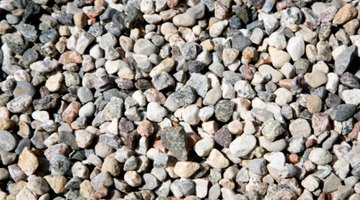How to Properly Use Stones Instead of Grass in a Lawn Area
Grass lawns may be attractive, but maintenance is often challenging for homeowners with little time or gardening skills. Fortunately, there are alternative ground covers for lawn areas that are less time-intensive, such as stones. Stone offers several benefits to the homeowner.

When used as mulch, it protects the soil and prevents weeds from growing. Decorative stones in the lawn area can also complement a home and increase its value.
Things You Will Need
- Rake
- Shovel
- Pre-emergent herbicide
- Geotextile fabric
- Anchor pins
- Scissors
-
Clear the area of grass, sod, weeds and debris with gardening tools, such as rakes and shovels. Level the soil so that there are no mounds or hills and fill up any holes with more soil. Treat the soil with a pre-emergent herbicide to prevent the growth of weeds.
-
Unroll the geotextile fabric over the soil, starting at from one end of the lawn area and working your way across. Cut the fabric with scissors when you get to the other end. If the work area is wider than the geotextile fabric then lay strips of the fabric until it is covered. Let the strips overlap by at least 3 inches. Secure the overlapping areas with anchor pins.
-
Spread several inches of the stone on the geotextile fabric. Ensure that the stone is at uniform depth all over the area. According to Cornell University Extension, uneven spots are susceptible to weeds and leave the soil unprotected.
Warning
Stones increase the temperature of the soil and the glare from sunlight. Do not use limestone if you will have acid-loving plants nearby. Limestone will increase the pH content of surrounding soil.
The Drip Cap
- Grass lawns may be attractive, but maintenance is often challenging for homeowners with little time or gardening skills.
- Fortunately, there are alternative ground covers for lawn areas that are less time-intensive, such as stones.
- Unroll the geotextile fabric over the soil, starting at from one end of the lawn area and working your way across.
- Secure the overlapping areas with anchor pins.
References
- "The Mulch Book: A Complete Guide for Gardeners"; Stu Campbell; Storey Publishing, 1991
Writer Bio
Tina Amo has been writing business-related content since 2006. Her articles appear on various well-known websites. Amo holds a Bachelor of Science in business administration with a concentration in information systems.
Photo Credits
- Jupiterimages/Photos.com/Getty Images
- Jupiterimages/Photos.com/Getty Images
More Articles



